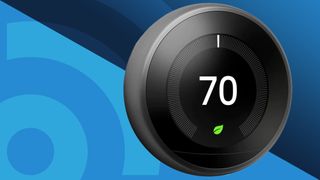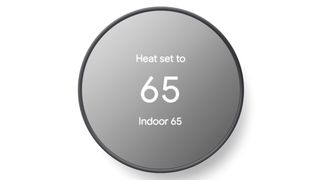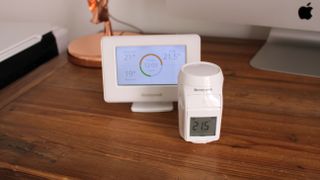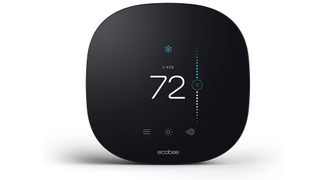The best smart thermostat 2024: save money with smart energy tech
Tech to keep the temperature just-so

The best smart homes can make heating and cooling more convenient, and maybe save you money too; by allowing you to remotely control your home temperature, they can help reduce your energy bills and your environmental footprint. You can create automatic routines so that your home is always at the right temperature, and some can even tell when you're coming home from work or school and get everything cozy or cool for your arrival.
Unfortunately, finding the best smart thermostat isn't as easy as it could be. Matter compatibility, which makes smart home kit work with more smart home platforms, is still relatively rare: only one of the thermostats here, Google's Nest Learning Thermostat, is currently Matter-compatible. That means it's important to check that your shortlisted thermostats will work with your chosen smart home platform, whether that's Amazon's Alexa, Google Home or Apple's HomeKit.
Smart thermostats are easy to use once installed: you can control them via a smartphone app, and in many cases you can also control them with your voice if you have one of the best smart speakers. You can also combine them in smart home groups with other tech, such as best smart plugs and best smart lights, to create wake-up and bedtime routines.
Smart thermostats pay for themselves pretty quickly, we've found. Every smart thermostat here can control a single space, but some also have companion smart radiator valves. This does add to the initial setup cost, however, and for smaller properties it'll take a long time before they pay for themselves. To help you find the right option for you, we’ve applied our expertise as well as hands-on testing to bring you the best smart thermostats available right now, including from well-known brands such as Honeywell, Ecobee, and Google’s Nest.
The best smart thermostats 2024
Why you can trust TechRadar

Specifications
Reasons to buy
Reasons to avoid
The Nest Learning Thermostat (third generation) strikes the right balance between style and smarts, making it our pick for the best smart thermostat you can buy. It learns your routines and adjusts itself accordingly, meaning that over time your heating system can actually adapt to suit your needs without you having to do anything. And now that Matter compatibility has been added it's widely compatible with the key smart home platforms.
It also benefits from location-based features that track where your phone is and will turn the heating on or off depending on your location. But don't worry, it won't turn off the heating and leave your guests to freeze when you're out, as its built-in sensors can detect whether there's anyone at home.
The main criticisms of the Nest Learning Thermostat are that it doesn't offer zonal control. So while you'll be able to digitally control your property as a whole, you'll still have to adjust individual radiators manually.
Read the full Nest Learning Thermostat 3rd generation review

2. Google Nest Thermostat
Specifications
Reasons to buy
Reasons to avoid
The Google Nest Thermostat was launched in the US in October 2020 and replaced the Google Nest Thermostat E as the brand's more affordable smart thermostat offering. However, the Nest Thermostat E is still available in the UK.
It builds on the Nest Thermostat E's white plastic design by being available in four different colored trims, which complement the screen's shade. However, as it's relatively smaller than most non-smart thermostats, you'll likely need an additional trim plate to cover up the holes when installing this model. Sadly it doesn't come with a stand as the Nest Learning Thermostat does, so it can only be wall-mounted.
It has the same simple-to-use app as the Nest Thermostat E, and once again, to keep the price low, it doesn't have any self-learning capabilities as the Nest Learning Thermostat does. It's also not compatible with Google's Temperature Sensor, so it only knows the temperature of the room it is located in.
Should I buy the Google Nest Thermostat?

Specifications
Reasons to buy
Reasons to avoid
If you want a smart thermostat that forms the basis of a smart home ecosystem you can build on, Hive Active Heating 2 is a good fit. The thermostat itself is a collaboration between Hive and Swiss designer Yves Béhar, who's responsible for everything from the August smart lock to PayPal's branding. That top-quality styling makes the Hive Active Heating thermostat something you'll be proud to have on your wall.
When it comes to the ecosystem, Hive offers a range of home security cameras, smart lights, and smart plugs, all of which can be controlled by the Hive app. While testing, we found that its simple interface and easy voice assistant integration made it a breeze to use. It's worth noting that, unlike Nest, there's no motion sensor built into the thermostat, and the mirrored finish is prone to fingerprints.
Read the full Hive Thermostat review

Specifications
Reasons to buy
Reasons to avoid
The Honeywell Evohome gives you total control over your home, with individual thermostats for each radiator enabling you to set an independent heating schedule for every room in your house.
It's difficult to grasp what a difference this feature makes until you've tried it for yourself. But, if you live in a house where different inhabitants prefer a different temperature, or if one room always seems hotter or colder than the others, this system will be a godsend. Moreover, it works with under-floor heating, too, so even if you have a large and complicated heating system, Evohome gives you total control over all of it via an app that's a pleasure to use.
The control panel and radiator thermostats aren't going to win any design awards, coming as they do in plain white plastic, but that's not really the point of the Evohome. It's expensive, too - as you'll need a smart valve for each radiator in your home. However, it's worth it for the granular control you get over your heating.
Read the full Honeywell Evohome review

5. Ecobee 3 Lite Smart Thermostat
Specifications
Reasons to buy
Reasons to avoid
OK, so not everyone needs another device with Alexa built-in. (We get it, guys, you can build Alexa into anything!) However, if you're in the camp of people with too many Alexa devices, the Ecobee 3 Lite is the perfect solution - it's just the smart thermostat without the smart assistant.
Easy to install and simple to use, we were impressed with the AC Overcool to Dehumidify feature, which utilizes your AC to lower indoor humidity.
That said, the Ecobee 3 is still compatible with all the leading smart home ecosystems. (Ecobee was the first smart thermostat compatible with Alexa, believe it or not.) But if you want the all the extras, like room sensors that can detect temperatures in certain spots in your home, you'll have to buy them separately.
Should I buy the EcoBee 3 Lite?

Specifications
Reasons to buy
Reasons to avoid
We tested the WundaSmart Starter Kit, which we feel brings something new to the stuffed smart thermostat market. It uses two gadgets in each room to precisely control the temperature: a stylish wireless thermostat and a smart radiator head, which replaces any existing TRVs (thermostatic radiator valves) on your radiators, allowing you to control them individually from the smartphone app.
It connects to your boiler via a module - or HubSwitch - and uses its own (low energy seeker signal RF) system to connect with the thermostats and radiator heads. It's really clever in doing this. It supports up to 30 rooms and 50 radiators, more than any other system.
You can schedule (via the app) when you want the house to be heated; override it to boost individual zones and detect when windows are open. It'll even learn how long your house retains heat and switch the boiler on or off if it deems it necessary. It's also compatible with Google Home and Amazon Alexa if you wish to control it with your voice.
Read the full Wunda WundaSmart review

Specifications
Reasons to buy
Reasons to avoid
As we've already mentioned, the Nest Thermostat E is still available in the UK. Unfortunately, it's made of white plastic, with a white coating on the plastic screen that can make it hard to see the information being displayed – but it does echo the design language of the original Nest Thermostat, so you'll be more than happy to have it on your wall.
As the Nest's smaller sibling, it benefits from industry-leading smarts, lacking only the most advanced features of the premium model, such as the self-learning capabilities. However, the app is simple to use too.
The Nest E is an excellent example of how to streamline a flagship product to make a cheap alternative without damaging the qualities that made the original great. Make no mistake, this isn't flagship quality for a bargain price, but it's great value for what it is.
Read the full Nest Thermostat E review

Specifications
Reasons to buy
Reasons to avoid
Love the idea of zonal heating control, but don't want to break the bank? Then Drayton Wiser is worth considering. You'll need a thermostat for each radiator in your home to get the most out of the system. Still, as thermostats are around a third cheaper than rival systems from Honeywell and Tado, the overall cost is more affordable.
It's simple to use and will switch the boiler on or off earlier than scheduled to ensure rooms in your home are at the temperature you want when you want them. It's also got Open Window Detection to help stop energy wastage by switching off the boiler if it detects a window has been opened and works with Alexa and Google Assistant.
However, it's not the most stylish of thermostats on the market, and there's no way to see the room's temperature from the radiator thermostat itself - you'll need to open the app on your smartphone. That said, it's hard to beat if you're on a budget and want complete control over your heating.
Read the full Drayton Wiser review

9. Ecobee SmartThermostat
Specifications
Reasons to buy
Reasons to avoid
If available where you live, the Ecobee Smart Thermostat with voice control is well-worth auditioning for your smart home setup. Unlike any other entries on this list, the Ecobee4 comes with Alexa built right in. Thanks to a software update, the smart thermostat also offers access to Siri - Apple's voice assistant (although you will need a HomePod Mini in your home to process the requests).
That means that it is a great thermostat that can save you bundles on your energy bill each month and doubles as a conduit to Alexa and its 10,000-strong library of skills or Siri and all the home automation Apple's voice assistant can bring. It's easy to install, is self-learning, and will adjust your schedule accordingly as it learns how quickly your house heats up and cools down.
While Ecobee may not have the same clout that Nest has garnered in the last few years, it remains one of the best thermostats on the market, bar none.
Should I buy the Ecobee Smart Thermostat with voice control?

10. Amazon Smart Thermostat
Specifications
Reasons to buy
Reasons to avoid
If you're on a tight budget, the Amazon Smart Thermostat is the ideal choice to remotely control your heating and cooling system, as it's almost half the price of other models on this list. Simple to use, the Amazon Smart Thermostat pairs with some Alexa devices in your home and uses your interaction with the best smart speakers to work out how it should adjust the heating. For example, saying Goodnight to Alexa will turn the heating off as it knows you're off to bed.
However, as Alexa isn't built-in to the smart thermostat, you will need to purchase a compatible smart speaker if you don't already have one. Amazon also says the more Echos there are in your house, the more accurate Alexa Hunches becomes, which could work out costly to get the most out of it.
There's no option for zonal control through radiator thermostats either, and the plastic design isn't stylish, but it's worth considering for those that already have an Echo or two.
Should I buy the Amazon Smart Thermostat?
How to choose the best smart thermostat for you
Before selecting the right smart thermostat for you, there are some aspects to consider. As we’ve already mentioned, there are two types of smart thermostats to consider. Smart thermostats that control your system as a whole are usually more affordable and easier to install than smart thermostats that offer zonal control. However, you may find you’re still heating or cooling rooms that you’re not using and subsequently wasting energy and money.
Smart thermostats that offer zonal control are more expensive as you’ll need to install a smart valve on each radiator or cooling outlet - this allows you to heat or cool each individual room to a different temperature.
Some smart thermostats use AI to adjust your heating and cooling schedule based on how long it takes your home to heat up or cool down. In contrast, others include sensors that automatically switch the heating and cooling system off if they detect an open window or think no one is using the house at the time, saving even more energy.
Finally, not all smart thermostats are compatible with all voice assistants, so if you already use a voice assistant in your home, check whether it will integrate with your chosen smart thermostat. Also, consider whether it will integrate with your own smart home devices, such as the best home security cameras, video doorbells, and smart lights.
FAQs about smart thermostats
Can you replace a regular thermostat with a smart thermostat?
The short answer is yes, but we recommend calling in professional help if you want to convert your regular thermostat into a smart thermostat. This is because the process requires some relatively complex electrical work, which shouldn't be attempted unless you know what you're doing.
First, you need to find out what wiring you already have and then look for a smart thermostat that matches your existing thermostat's voltage. If you want to do the installation yourself, ensure your HVAC system has been turned off before starting. Then it's usually a case of changing the connections from your 'dumb' thermostat and connecting them to your smart replacement but always check the instructions.
There are also some compatibility issues between some heating system and some smart thermostats: for example in our apartment it turned out that the heating system needed to be wired differently from the standard setup, something we wouldn't have known or been able to solve if we'd been doing the installation ourselves.
Is it worth getting a smart thermostat?
Smart thermostats can make life easier as well as potentially put an end to wasting energy. For example, if you're going to be late home from work, you can switch the heating or air conditioning off remotely, so it's running full blast in an empty house. Similarly, suppose you've been away on holiday. In that case, a smart thermostat can ensure your home is at a cozy temperature as soon as you walk through the door, rather than waiting hours for the property to warm up as the HVAC system has been switched off for a week or two.
When it comes to saving money, many smart thermostats make bold claims about just how much you can claw back by installing one. For example, energy-saving standards firm Energy Star estimates having a smart thermostat installed will use around 8% less energy a year, equating to $50 in the US - although this will differ in other territories.
Using your heating and cooling system will also affect just how much of a saving you make. If you have it running all the time, chances are you'll generate some hefty savings, but if you already use a schedule to adjust the temperature in your home, the savings won't be as significant, but every little helps.
Either way, we certainly believe that the convenience and savings a smart thermostat offers make it more than worth it.
How do smart thermostats work?
Smart thermostats connect to your home Wi-Fi network and can be controlled via an app on your smartphone, or you can use a voice assistant to switch your home’s heating and cooling system. Depending on the model you can often control your smart thermostat even when you're not at home, although that may depend on the package you buy: for example with a Hive smart thermostat you need to have a Hive Hub to connect the thermostat to the internet.
As well as adjusting the temperature in your home, most smart thermostats also enable you to set schedules, provide a report charting your energy use and even stop your heating coming on at all because, for example, you’re heading out of town.
Like most home smart home gadgets, smart thermostats can also be used in home automation that uses other smart home gadgets, such as smart lights and smart plugs, all controlled simultaneously. So you can turn the heating up, dim the light and watch your favorite TV show with one command.
What are the disadvantages of a smart thermostat?
As with any new device or piece of technology that we've been told will improve our lives, some downsides do exist. Firstly, there's the initial cost, though the best smart thermostats in this guide do vary in price, and there's an argument that many will pay for themselves once your heating becomes more energy-efficient. There's also installation which, as we have outlined above, can mean you need to pay for professional installation.
How we tested these smart thermostats
To find out which are the best smart thermostats on the market, we assess how easy they are to install and control. Then, we evaluate their responsiveness when switching the heating and cooling systems on or off from a smartphone, both when we’re away from home and close by. We also judge how effectively AI amends the heating and cooling schedule based on how quickly or slowly your house changes temperature and any sensors that detect activity (or lack of it) and open windows.
We also appraise each design on its durability and how effectively Alexa, Google Assistant, or Siri respond to commands related to the smart thermostat. We also assess any extra kit available for the smart thermostat, such as hubs and radiator valves, and consider whether it requires reading a thick instruction manual before use.
Get daily insight, inspiration and deals in your inbox
Get the hottest deals available in your inbox plus news, reviews, opinion, analysis and more from the TechRadar team.

Michelle Rae Uy is the former Computing Reviews and Buying Guides Editor at TechRadar. She's a Los Angeles-based tech, travel and lifestyle writer covering a wide range of topics, from computing to the latest in green commutes to the best hiking trails. She's an ambivert who enjoys communing with nature and traveling for months at a time just as much as watching movies and playing sim games at home. That also means that she has a lot more avenues to explore in terms of understanding how tech can improve the different aspects of our lives.
